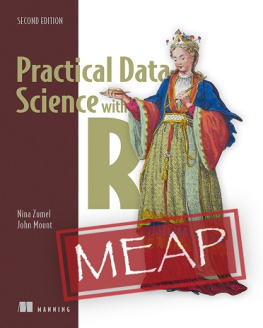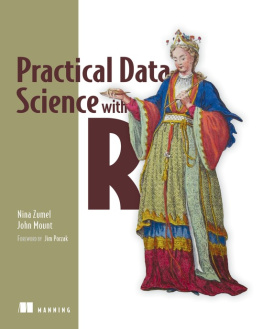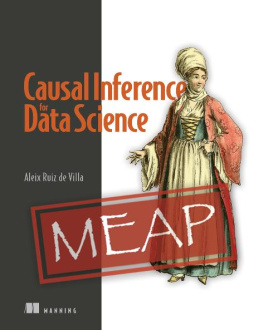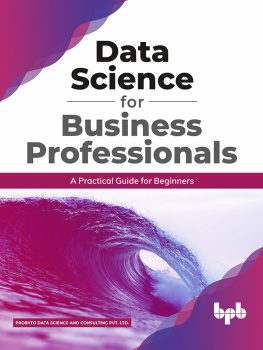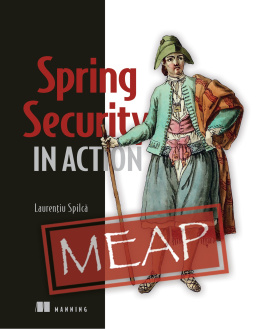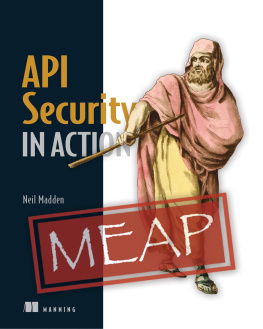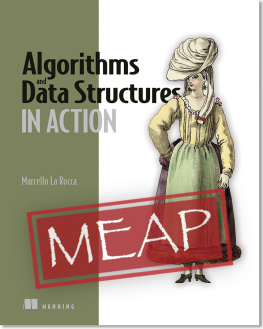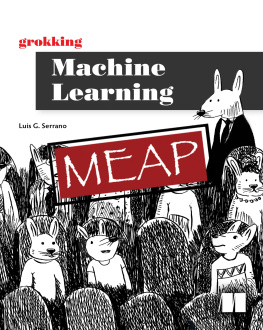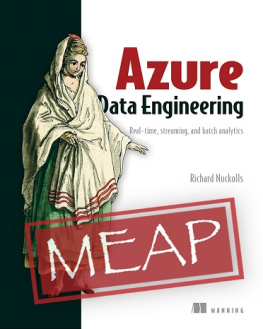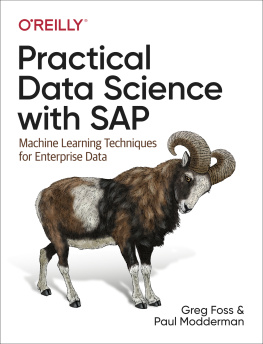Nina Zumel - Practical Data Science with R, Second Edition MEAP V06
Here you can read online Nina Zumel - Practical Data Science with R, Second Edition MEAP V06 full text of the book (entire story) in english for free. Download pdf and epub, get meaning, cover and reviews about this ebook. year: 2020, publisher: Manning Publications Co., genre: Home and family. Description of the work, (preface) as well as reviews are available. Best literature library LitArk.com created for fans of good reading and offers a wide selection of genres:
Romance novel
Science fiction
Adventure
Detective
Science
History
Home and family
Prose
Art
Politics
Computer
Non-fiction
Religion
Business
Children
Humor
Choose a favorite category and find really read worthwhile books. Enjoy immersion in the world of imagination, feel the emotions of the characters or learn something new for yourself, make an fascinating discovery.
- Book:Practical Data Science with R, Second Edition MEAP V06
- Author:
- Publisher:Manning Publications Co.
- Genre:
- Year:2020
- Rating:4 / 5
- Favourites:Add to favourites
- Your mark:
- 80
- 1
- 2
- 3
- 4
- 5
Practical Data Science with R, Second Edition MEAP V06: summary, description and annotation
We offer to read an annotation, description, summary or preface (depends on what the author of the book "Practical Data Science with R, Second Edition MEAP V06" wrote himself). If you haven't found the necessary information about the book — write in the comments, we will try to find it.
Practical Data Science with R, Second Edition MEAP V06 — read online for free the complete book (whole text) full work
Below is the text of the book, divided by pages. System saving the place of the last page read, allows you to conveniently read the book "Practical Data Science with R, Second Edition MEAP V06" online for free, without having to search again every time where you left off. Put a bookmark, and you can go to the page where you finished reading at any time.
Font size:
Interval:
Bookmark:


You can download the most up-to-date version of your electronic books from your Manning Account at .
Manning Publications Co. We welcome reader comments about anything in the manuscript - other than typos and other simple mistakes. These will be cleaned up during production of the book by copyeditors and proofreaders.
https://forums.manning.com/forums/practical-data-science-with-r-second-edition
Dear MEAP Subscribers:
Welcome to the MEAP for Practical Data Science with R, Second Edition!
Our goal when we began Practical Data Science with R was to write the book that we wish we had when we began our data science careers. We are proud of the result, and we are excited to have the opportunity to make our book even better.
Our intent is to present data science from a pragmatic, practice-oriented viewpoint. We concentrate on the process of data science, from the planning stages of a project, through the data collection and exploration, to the modeling, and finally to deployment and the sharing of results.
We present enough of the theory behind the various methods to enable a user to understand when a technique is or is not appropriate, and how to anticipate and diagnose potential problems. We also concentrate on the nitty-gritty of data science, especially cleaning, preparing and wrangling data before modeling.
The book includes free code and data to reproduce almost every analysis and graph in the text (and there are a lot of them). Please work along with the examples as you read, to get the most out of the book.
We hope you enjoy Practical Data Science with R, Second Edition. We look forward to hearing from you on the forums.
Warm regards,
Nina Zumel
John Mount

Part 1:
Part 2:
Part 3:Working in the real world
Appendixes:
Part 1
In part 1, we concentrate on the most essential tasks in data science: working with your partners, defining your problem, and examining your data.
Chapter 1 covers the lifecycle of a typical data science project. We look at the different roles and responsibilities of project team members, the different stages of a typical project, and how to define goals and set project expectations. This chapter serves as an overview of the material that we cover in the rest of the book and is organized in the same order as the topics that we present.
Chapter 2 dives into the details of loading data into R from various external formats and transforming the data into a format suitable for analysis. It also discusses the most important R data structure for a data scientist: the data frame. More details about the R programming language are covered in appendix A.
Chapters 3 and 4 cover the data exploration and treatment that you should do before proceeding to the modeling stage. In chapter 3, we discuss some of the typical problems and issues that youll encounter with your data and how to use summary statistics and visualization to detect those issues. In chapter 4, we discuss data treatments that will help you deal with the problems and issues in your data. We also recommend some habits and procedures that will help you better manage the data throughout the different stages of the project.
On completing part 1, youll understand how to define a data science project, and youll know how to load data into R and prepare it for modeling and analysis.
This chapter covers
Defining data science
Defining data science project roles
Understanding the stages of a data science project
Setting expectations for a new data science project
Data science is a cross-disciplinary practice that draws on methods from data engineering, descriptive statistics, data mining, machine learning, and predictive analytics. Much like operations research, data science focuses on implementing data-driven decisions and managing their consequences. For this book, we will concentrate on data science as applied to business and scientific problems, using the above techniques.
The data scientist is responsible for guiding a data science project from start to finish. Success in a data science project comes not from access to any one exotic tool, but from having quantifiable goals, good methodology, crossdiscipline interactions, and a repeatable workflow.
This chapter walks you through what a typical data science project looks like: the kinds of problems you encounter, the types of goals you should have, the tasks that youre likely to handle, and what sort of results are expected.
We'll use a concrete, real world example to motivate the discussion in this chapter.
Example Scenario.Suppose youre working for a German bank. The bank feels that its losing too much money to bad loans and wants to reduce its losses. To do so, they want a tool to help loan officers more accurately detect risky loans.
This is where your data science team comes in.
Data science is not performed in a vacuum. Its a collaborative effort that draws on a number of roles, skills, and tools. Before we talk about the process itself, lets look at the roles that must be filled in a successful project. Project management has been a central concern of software engineering for a long time, so we can look there for guidance. In defining the roles here, weve borrowed some ideas from Fredrick Brookss surgical team perspective on software development, as described in The Mythical ManMonth: Essays on Software Engineering (AddisonWesley, 1995). We also borrowed ideas from the agile software development paradigm.
Lets look at a few recurring roles in a data science project in table 1.1.
Table 1.1. Data science project roles and responsibilities
Role | Responsibilities |
Project sponsor | Represents the business interests; champions the project |
Client | Represents end users interests; domain expert |
Data scientist | Sets and executes analytic strategy; communicates with sponsor and client |
Data architect | Manages data and data storage; sometimes manages data collection |
Operations | Manages infrastructure; deploys final project results |
Sometimes these roles may overlap. Some rolesin particular client, data architect, and operationsare often filled by people who arent on the data science project team, but are key collaborators.
The most important role in a data science project is the project sponsor. The sponsor is the person who wants the data science result; generally they represent the business interests. In the loan application example, the sponsor might be the bank's head of Consumer Lending. The sponsor is responsible for deciding whether the project is a success or failure. The data scientist may fill the sponsor role for their own project if they feel they know and can represent the business needs, but thats not the optimal arrangement. The ideal sponsor meets the following condition: if theyre satisfied with the project outcome, then the project is by definition a success.
Font size:
Interval:
Bookmark:
Similar books «Practical Data Science with R, Second Edition MEAP V06»
Look at similar books to Practical Data Science with R, Second Edition MEAP V06. We have selected literature similar in name and meaning in the hope of providing readers with more options to find new, interesting, not yet read works.
Discussion, reviews of the book Practical Data Science with R, Second Edition MEAP V06 and just readers' own opinions. Leave your comments, write what you think about the work, its meaning or the main characters. Specify what exactly you liked and what you didn't like, and why you think so.

